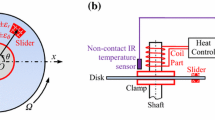Abstract
Membrane stresses alter the dynamic behavior and stability of circular-disk elements, such as circular saws and grinding wheels, by shifting the disk's natural frequency spectrum. Such shifts are directly related to variation in the critical rotation speed at which standing-wave-resonance instability occurs. Negative critical-speed variations reduce the disk stability, and positive critical-speed variations increase stability.
The present paper theoretically and experimentally investigates the relationship between the state of disk-membrane stress, critical rotation speed, and the frequency spectrum in radially symmetric disk problems. The observed critical-speed variations are theoretically predictable and well understood. The approach of a shifting critical-speed instability can be predicted by monitoring the disk-frequency spectrum.
Similar content being viewed by others
Abbreviations
- a :
-
clamping radius
- a :
-
a/b normalized clamping radius
- b :
-
peripheral radius
- c :
-
Initial-stress radius at which the plate is compressed between rollers at gage pressure, P
- c :
-
c/d normalized initial-stress radius
- \(\tilde H\) :
-
1/2 disk thickness
- n :
-
number of nodal diameters
- P :
-
gage pressure applied to initial stressing rollers
- ωo :
-
rotation speed
- Ωc :
-
critical rotation speed
References
Tobias, S. A. andArnold, R. N., “Influence of Dynamical Imperfections on the Vibration of Rotating Disks,”Proc. Inst. Mech. Engrs.,171,669–690 (1957).
Dugdale, D. S., “Stiffness of a Spinning Disc Clamped at Its Centre”,Jnl. Mech. Phys. Solids,14,349–356 (1966).
Mote, C. D., Jr., “Free Vibration of Initially Stressed Circular Disks,”Trans. ASME,87B (2),258–264 (May1965).
Mote, C. D., Jr., “Natural Frequencies in Annuli with Induced Thermal Membrane Stresses,”Trans. ASME,89B (4),611–618 (Nov.1967).
Mote, C. D., Jr., “Stability of Circular Plates Subjected to Moving Loads,”Jnl. of the Franklin Inst., 290 (4),329–344 (Oct.1970).
Nieh, L. T. and Mote, C. D., Jr., “An Experimental Investigation of the Dynamic Stability of Thin Circular Disks,” Univ. of Calif. Forest Prod. Lab. Report No. 35.01.73 (June 1969).
Mote, C. D., Jr., “Formulation of Discrete Element Models for Stress and Vibration Analysis of Plates,” Univ. of Calif. Forest Prod. Lab. Report No. 35.01.77, (Jan. 1970).
Mote, C. D., Jr., “Unsymmetrical Transient Heat Conduction: Rotating Disk Applications,”Trans. ASME,92B (1),181–190 (Feb.1970).
Author information
Authors and Affiliations
Rights and permissions
About this article
Cite this article
Mote, C.D., Nieh, L.T. Control of circular-disk stability with membrane stresses. Experimental Mechanics 11, 490–498 (1971). https://doi.org/10.1007/BF02327688
Issue Date:
DOI: https://doi.org/10.1007/BF02327688




